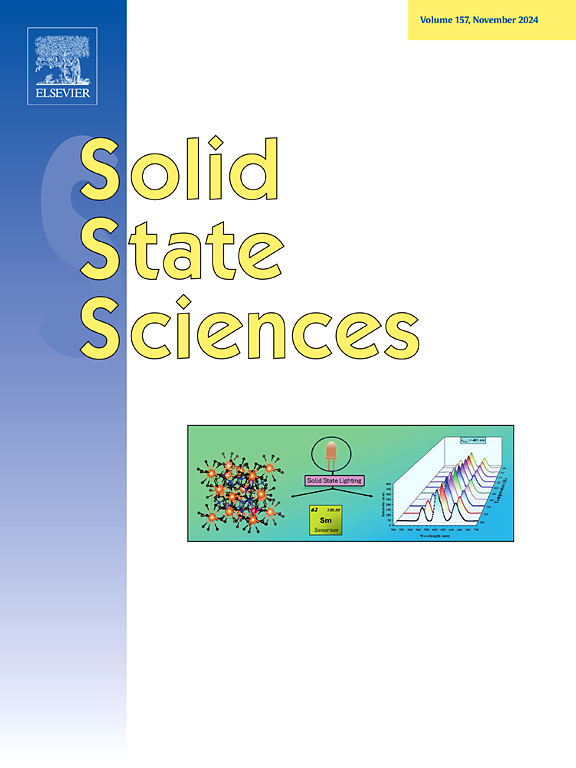Optical, magnetic and dielectric properties of CaO-B2O3-V2O5 glasses
IF 3.3
3区 化学
Q2 CHEMISTRY, INORGANIC & NUCLEAR
引用次数: 0
Abstract
In this present study, glass materials belonging to the CaO-B2O3-V2O5 system with different concentrations of V2O5 were elaborated using the melt-quenching process. The main aim of this paper is to investigate the optical, magnetic and dielectric characteristics of these vitreous materials, and thus determine the impact of vanadium oxide. The optical parameters of the elaborated glassy samples, including the cut-off wavelength, band gap, Urbach energy, refractive index and molar refraction, are investigated in this work. The observed variations in cut-off wavelength, gap energy and refractive index indicated an increase in non-bridging oxygen atoms (NBO) with increasing V2O5 content, which results in the conversion of BO3 to BO4 units. Urbach's energy values indicate that the glass samples with a higher vanadium content exhibit a more stable and uniform glass structure. The introduction of V2O5 increased the refractive index and molar refraction. Furthermore, the magnetic properties revealed the paramagnetic behavior for all the glasses studied. Diamagnetic behavior at higher temperatures was also observed for two glasses, CBV1 and CBV2, as the content of V2O5 decreased. The transition from diamagnetic to the paramagnetic state observed for CBV1 and CBV2 indicates the transformation of V5+ to V4+. The dielectric parameters of glass samples CBV2 and CBV3 increase at higher temperatures, with CBV3 exhibiting a transition between the ferroelectric and the paraelectric phases. Moreover, the study of conductivity reveals the semiconducting nature of the studied glasses. The activation energy decreased with rising vanadium oxide content.

CaO-B2O3-V2O5玻璃的光学、磁性和介电性能
本研究采用熔体淬火工艺制备了不同V2O5浓度的CaO-B2O3-V2O5体系玻璃材料。本文的主要目的是研究这些玻璃材料的光学、磁性和介电特性,从而确定氧化钒的影响。研究了制备的玻璃样的光学参数,包括截止波长、带隙、乌尔巴赫能、折射率和摩尔折射率。观察到的截止波长、间隙能和折射率的变化表明,随着V2O5含量的增加,非桥接氧原子(NBO)增加,导致BO3向BO4单位转化。Urbach能量值表明,钒含量高的玻璃样品具有更稳定、均匀的玻璃结构。V2O5的加入提高了折射率和摩尔折射率。此外,磁性能揭示了所研究的所有玻璃的顺磁性。随着V2O5含量的降低,CBV1和CBV2两种玻璃在较高温度下的抗磁性行为也被观察到。CBV1和CBV2从抗磁性到顺磁性的转变表明了V5+向V4+的转变。温度越高,玻璃样品CBV2和CBV3的介电参数越高,其中CBV3表现出铁电相和准电相之间的转变。此外,电导率的研究揭示了所研究的玻璃的半导体性质。活化能随氧化钒含量的增加而降低。
本文章由计算机程序翻译,如有差异,请以英文原文为准。
求助全文
约1分钟内获得全文
求助全文
来源期刊

Solid State Sciences
化学-无机化学与核化学
CiteScore
6.60
自引率
2.90%
发文量
214
审稿时长
27 days
期刊介绍:
Solid State Sciences is the journal for researchers from the broad solid state chemistry and physics community. It publishes key articles on all aspects of solid state synthesis, structure-property relationships, theory and functionalities, in relation with experiments.
Key topics for stand-alone papers and special issues:
-Novel ways of synthesis, inorganic functional materials, including porous and glassy materials, hybrid organic-inorganic compounds and nanomaterials
-Physical properties, emphasizing but not limited to the electrical, magnetical and optical features
-Materials related to information technology and energy and environmental sciences.
The journal publishes feature articles from experts in the field upon invitation.
Solid State Sciences - your gateway to energy-related materials.
 求助内容:
求助内容: 应助结果提醒方式:
应助结果提醒方式:


